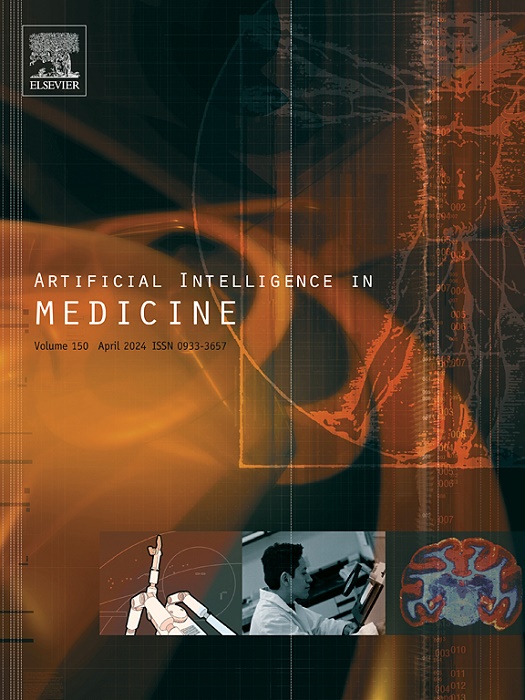基于边界感知和CNN-transformer融合网络的皮肤病灶分割的病灶边界检测
IF 6.2
2区 医学
Q1 COMPUTER SCIENCE, ARTIFICIAL INTELLIGENCE
引用次数: 0
摘要
在复杂的皮肤病变分割任务中,传统的卷积神经网络往往难以捕获全局信息,并处理模糊的边界。为了应对这一挑战,我们提出了MPBA-Net,这是一种集成了多池融合和边界感知优化的混合网络。该网络结合卷积神经网络(CNN)和Transformer生成丰富的皮肤病变特征图,进行全面的特征提取。具体而言,我们在Transformer编码器层引入了边界感知注意门(BAAG)模块,并在网络末端添加了边界交叉注意(BCA)模块,以捕获关键的皮肤病变边界特征。此外,我们开发了一个多池融合(MPF)模块,该模块通过融合改进的空间金字塔(SP)和亚特劳斯空间金字塔池(ASPP)来提取全局多尺度特征。为了优化训练,我们设计了一个基于二元交叉熵(BCE)的点损失函数,并将其与骰子损失函数相结合,形成一个混合损失函数。该方法不仅提高了分类性能,而且提供了更精确的分割结果与地面真值注释之间的相似性度量。在ISIC2018数据集上的消融实验验证了我们的融合策略和网络改进的有效性。在ISIC2016、ISIC2017和ISIC2018数据集上的对比实验表明,MPBA-Net的Dice指数在这三个数据集上分别达到91.47%、87.04%和88.93%,优于其他比较分割方法。定量和定性结果表明,该方法提高了皮肤病变分割的准确性,有助于皮肤科医生的临床诊断和治疗。我们的代码可在https://github.com/FengYuchenGuang/MPBA-Net上获得。本文章由计算机程序翻译,如有差异,请以英文原文为准。
Lesion boundary detection for skin lesion segmentation based on boundary sensing and CNN-transformer fusion networks
Traditional convolutional neural networks often struggle to capture global information and handle ambiguous boundaries during complex skin lesion segmentation tasks. To tackle this challenge, we proposed MPBA-Net, a hybrid network that integrates multi-pooling fusion and boundary-aware refinement. The network integrated Convolutional Neural Network (CNN) and Transformer to generate rich skin lesion feature maps for comprehensive feature extraction. Specifically, we introduced a boundary-aware attention gate (BAAG) module in the Transformer encoder layer and added a boundary cross attention (BCA) module at the end of the network to capture critical skin lesion boundary features. Additionally, we developed a multi-pooling fusion (MPF) module that extracts global multi-scale features by fusing improved Spatial Pyramid (SP) and Atrous Spatial Pyramid Pooling (ASPP). To optimize training, we designed a Point Loss derived from Binary Cross-Entropy (BCE) and combined it with Dice Loss to form a hybrid loss function. This approach not only enhances classification performance but also provides more precise measurement of the similarity between segmentation results and ground truth annotations. Ablation experiments on the ISIC2018 dataset validated the effectiveness of our fusion strategies and network improvements. Comparative experiments on the ISIC2016, ISIC2017, and ISIC2018 datasets showed that the Dice index of MPBA-Net outperformed other comparative segmentation methods in all three datasets, achieving 91.47 %, 87.04 %, and 88.93 %, respectively. Quantitative and qualitative results demonstrate that our method improves skin lesion segmentation accuracy, aiding dermatologists in clinical diagnosis and treatment. Our code is available at https://github.com/FengYuchenGuang/MPBA-Net.
求助全文
通过发布文献求助,成功后即可免费获取论文全文。
去求助
来源期刊

Artificial Intelligence in Medicine
工程技术-工程:生物医学
CiteScore
15.00
自引率
2.70%
发文量
143
审稿时长
6.3 months
期刊介绍:
Artificial Intelligence in Medicine publishes original articles from a wide variety of interdisciplinary perspectives concerning the theory and practice of artificial intelligence (AI) in medicine, medically-oriented human biology, and health care.
Artificial intelligence in medicine may be characterized as the scientific discipline pertaining to research studies, projects, and applications that aim at supporting decision-based medical tasks through knowledge- and/or data-intensive computer-based solutions that ultimately support and improve the performance of a human care provider.
 求助内容:
求助内容: 应助结果提醒方式:
应助结果提醒方式:


